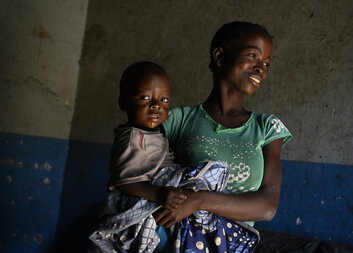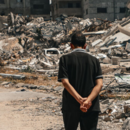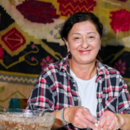More than half of Zambia's nearly 20 million people live below the poverty line. The country's malnutrition rate is one of the highest in the world, with nearly half the population unable to meet their minimum calorie requirements. More than one-third of children under five years of age are stunted. Poverty, inequality and the increasingly severe effects of climate change are exacerbating hunger levels. How is Caritas Czech Republic tackling malnutrition in Zambia?
Proper nutrition is essential
Patrah Mukwae Mwangala lives in a village in the Western province of Zambia. She works as a health volunteer trained by Caritas Czech Republic to help local communities. Today, Patrah regularly visits rural people and introduces them to ways to protect children from malnutrition.
"We weigh the children and measure them to check that they are developing properly and not suffering from malnutrition," Patrah says of her job. Community volunteers like her also show villagers how to prepare nutritious meals. In Zambia, there is a popular traditional dish called nshima, a maize porridge that, while filling, contains almost no nutrients. So volunteers in the villages show locals what to add to nshima to ensure that the children get a wholesome meal. They hold cooking demonstration classes, which are attended not only by pregnant and breastfeeding women but also by other people in the community. "Men are also welcome to know how to feed their pregnant wife and young children and what to buy for them," explains Mwiya Mulope, Caritas Czech Republic's project officer in western Zambia.
One such cooking demonstration is currently underway in the village of Nakato in Zambia's Western Province. Aongola Mubuyaeta is in charge of cooking today. Aongola learned how to prepare nutritious meals from Patrah and is now passing on the knowledge she has gained to others in her community. "Look, here we have different vegetables to add to the traditional nshima. To go along with that, we have bought fish from the market to make a completely nutritious dish," says Aongola as she begins preparing the meal, describing the entire cooking process. Around her, other community members sit on the ground and watch the preparation take place.
What causes malnutrition
Contrary to popular belief, malnutrition is not caused by overpopulation of the planet and the associated threat of food shortages. On the contrary, our planet's population has been growing for the last three years at the slowest rate since the end of the Second World War. In Nigeria, for example, the birth rate has fallen from an average of 5.8 children to 4.6 children per woman in just five years. In Senegal, there has been a decline from five children to four in ten years. In Zambia, the fertility rate has declined from seven children per woman in 1980 to four children today. Malnutrition has other causes and is usually a combination of several factors.
The most common causes of malnutrition include:
- Poor nutrition - insufficient protein and mineral intake, monotonous and unbalanced diet
- Poor maternal health - in addition, children of mothers who do not get enough vitamins and nutrients are more likely to suffer from malnutrition
- Poverty - poverty is one of the main causes of malnutrition in developing countries
- War and conflict - 230 million children worldwide live in war zones with the highest intensity of conflict. These children are at increased risk of death before the age of 5 and stunted growth due to malnutrition, among many other risks. In particular, in areas such as South Sudan, Syria and Yemen. Refugee children are also very often at risk of malnutrition.
- Climate change and associated crop failure - Zambia enjoys relative peace and political stability. Yet it is plagued by malnutrition, largely caused by climate change.
How malnutrition harms children's health and how community volunteers help detect it
For children under two, nutrition has a significant impact on their development. When children are malnourished, they have significantly weakened immune systems and develop poorly and are less resistant to common diseases. They may even die as a result of the common cold or diarrhoea.
In remote villages in western Zambia, far from health centres, it is difficult for local people to access quality health services. It is even more difficult to provide proper care for children under five, leading to high rates of malnutrition and poor child development. So in these places, health volunteers like Patrah help diagnose malnutrition. For example, they use what is called a MUAC tape, a simple plastic bracelet that measures the circumference of a child's arm. By its colour, the volunteer can tell if a child is suffering from malnutrition. The colour green means the child is well nourished, yellow indicates risk of malnutrition, orange indicates mild malnutrition and red indicates severe malnutrition. The volunteers also have a measuring board and a scale to check the children's proper development.
“Caritas Czech Republic trains community volunteers who then visit villagers to help combat malnutrition. As well as weighing and measuring the children in the village, they introduce them to the benefits of a balanced diet and emphasise that there must be more than one type of food on the plate," says Mwia Mulope from Caritas Czech Republic. "We have also introduced demonstration gardens in several local schools, where the school children themselves, together with their teachers, grow vegetables to add variety to their diets," adds Mwia.
The end of hunger by 2030?
The second UN Sustainable Development Goal is to eradicate hunger by 2030. But conflict, poverty, inequality and the increasingly severe effects of climate change are driving hunger rates ever higher. It is expected that 345.2 million people will suffer from hunger this year. Up to 828 million people worldwide do not know where their next meal will come from. More than 900,000 people are struggling to survive in the face of impending famine - ten times more than five years ago.
The situation has also worsened in Zambia. In 2022, the World Bank reclassified Zambia as a low-income country after it had been in the lower-middle-income category for a decade. The country's worsening situation has been caused by persistent poor economic performance, exacerbated by the Covid-19 pandemic. This has also had a negative impact on the country's problems with malnutrition.
A coordinated global effort is needed to eradicate hunger. This is the only way to eliminate all forms of malnutrition and ensure access to sufficient nutritious food for all. It is also important to support small farmers in developing countries so that they can withstand climate change and have a sufficient income. Caritas Czech Republic helps farmers in Zambia to adapt to climate change through innovations and introduces rural people to ways to prevent malnutrition.
We are fighting malnutrition in Zambia together with the World Food Programme and with the support of the Czech Development Agency.













